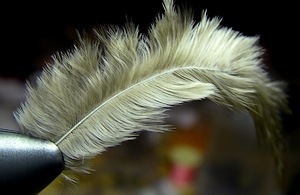Lead gray skies offered little hope so I swung by the Little Stinking to see what a week’s changes had wrought. The water was clear enough to fish but still much too high to wade – many tons of gravel have changed the entire streambed and scoured every vestige of weed and bank foliage.
With the vegetation gone the creek looks like a construction site. Barring another downpour it’ll be fishable next week.
I took advantage and banged out all my lingering chores; removing lock plates swollen by the wet and removing enough metal so the bolts once again lined up with door jambs.
The water table is being replenished, which makes the entire Central Valley rise nearly four feet. Naturally you hope your slab foundation rises with it, and every year some small thing winds up needing coaxing.
 With all the pressing chores finished I started working on the Caddis flies. I’d been sidetracked by an “old school” reference to Polly Rosborough – whose fur collared flies reminded me of Jack Gartside’s Sparrow nymph, which suggested Cal Bird’s woven bodies, and the drone of Clint Eastwood Spaghetti Westerns hummed in the background while I rediscovered my attraction to Philoplumes.
With all the pressing chores finished I started working on the Caddis flies. I’d been sidetracked by an “old school” reference to Polly Rosborough – whose fur collared flies reminded me of Jack Gartside’s Sparrow nymph, which suggested Cal Bird’s woven bodies, and the drone of Clint Eastwood Spaghetti Westerns hummed in the background while I rediscovered my attraction to Philoplumes.
Philoplumes (aftershaft feathers) are the little marabou feather attached to each pheasant body feather. They’re largely overlooked but Jack Gartside made great use of them on a lot of his flies, and were popular on the Gimp Nymph back in the 80’s.

The Gartside Sparrow uses the philoplume as the collar at the fly’s head. It’s quite delicate but offers considerable movement, and the fly is a tremendous caddis imitation. Tied in a variety of colors, using a similar shade of pheasant body as the hackle.
The original Sparrow has a tail of grizzly marabou which I omit on all but the largest sizes.
I thought I’d finished with the stoneflies, but the “Philo-urge” had me fiddling with a combination of Cal Bird’s techniques. Cal used a copper wire tail support on his steelhead flies which also added breadth to the body for woven materials.
I grabbed a hair collar from Polly, a philoplume from Gartside, and Cal’s tail and woven body to come up with flies destined for my box; it’s “tier’s prerogative” – untested intricate flies that only the creator gets to fish.

It’s not that they’ll catch more fish than anything else – they’re twice as much work as the rest of the box, so in-laws and relatives can just keep their grabby mitts off…
That was when I realized I hadn’t tied any of the patented-death stonefly nymphs that actually work. The orange and black variegated chenille monsters, complete with black rubberlegs. It’s the pattern you pass over enroute to the sexy woven body flies – thinking “if I was a fish, I’d eat those multi-colored sumbitches first.”
Huge mistake.

In the fly shop they look like Bluegill flies – when wet the orange turns brown and you’ve got mottled death on your hands.
I sure hope there’s a lot of stonefly activity this Spring, I’ve got an entire box full of shapes and colors and would be sorely put out if the fish wanted to eat the itty-bitty stuff instead.
I’m sure Carp would eat them too, so I’ll find something other than a tree branch to hang these on.

All great looking flies. Based on the quantities pictured, I’d say you went through about two pounds of coffee this past weekend.
Nice, but I still have no idea how you get the things to float.
Probably the same way you’d float a soft hackle.
TC – they lash to a tounge depressor, which after being dipped in floatant will bob like a cork.
Unfortunately, that weak grass stem you fish in unable to cast them – hence your bulging lower lip.
Nice Catch SMJ – while he’s waxing poetic about underwater flies on his blog, he comes over here to pizzle on our stuff…
Those Caddis are purdy!
badass. those halloween flies look like those mine laced tank traps from WWII.
The road to fly tying insanity is paved with philoplumes. So purty, so deadly, and so likely to break just as you tie them down.
Tacklebill: Yes, they’re really fragile – one of the reasons I put a pronounced collar on the fly, securing the Philo material from breaking up when the fish start mangling the fly.
Pingback: Jack Gartside (Passing to the Quieter Side) « SwittersB & Fly Fishing
Could you take a picture of just one of those stoneflies, so I could get some idea of the number of legs. Can’t see the forest for the stumps, there.
@Brantl – there are three sets of legs. There’s also a pair for the tail, and one for the feelers – making 5 total.
On smaller sizes I use two sets of legs plus the feelers and tail.
Better picture here:
http://singlebarbed.com/2010/04/14/the-giggles-die-right-about-the-time-the-fly-gets-wet/
Pingback: Chickabou replacement - The North American Fly Fishing Forum